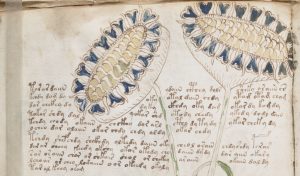The mystery of the Voynich Manuscript
The Voynich Manuscript is a handwritten book of about two hundred pages, several hundred years old, written in a script that doesn’t occur in any other known document, and richly illustrated with images that range from mundane to bizarre.
After its discovery in 1912 by Wilfrid Voynich, researchers quickly established that it was almost certainly not a plaintext in a human language, because the regularities in its text were very different from human languages in key features. They decided that it was almost certainly not a hoax, because they could not imagine a way in which a hoaxer centuries ago could have produced the complex statistical regularities in its text. That left a code as the last explanation. However, all the other codes from centuries ago were easily cracked by modern code breakers, but decades of work by the world’s best code breakers failed to find a plausible solution.

The Voynich Manuscript: image courtesy of the Beinecke Library
Gordon suspected that previous researchers had made a faulty assumption somewhere in their reasoning about the manuscript. He and Jo Hyde had been developing a method called Verifier for systematically testing for errors in research into difficult problems. Gordon tried out a lightweight version of this method on the manuscript as a test of method, and within a few weeks had found that a key assumption in previous work was faulty.
Previous researchers had assumed that the complex statistical regularities in the text of the manuscript could only have been produced by a complex process. However, complex features can arise easily from very simple processes, as in the case of fractals like the one below, which have an extremely complex form that derives from a very simple formula.

Public Domain, https://commons.wikimedia.org/w/index.php?curid=91161034
Within a few more weeks, Gordon found a low-tech way of producing semi-random (as opposed to truly random) meaningless text that had the same distinctive qualitative and quantitative features as the text in the manuscript. This doesn’t prove that the manuscript was a hoax, but it did show that there was a feasible method of producing text with the same unusual statistical properties as the text in the manuscript, using methods available when the manuscript was produced; there was a simple possible solution that didn’t require an ancient super-code.
If world-class researchers had missed a major faulty assumption in dealing with this problem, what are the implications for research into other problems that have gone unsolved for decades in other fields, such as medicine? Even the slimmed-down version of Verifier would take years to learn. So, since the Voynich Manuscript case, we’ve been working on ways of making it easy for other researchers to choose and use methods for spotting errors in their work, and for finding solutions more swiftly and efficiently. This talk ends with some examples of these methods that you can try out for yourself, after the talk.